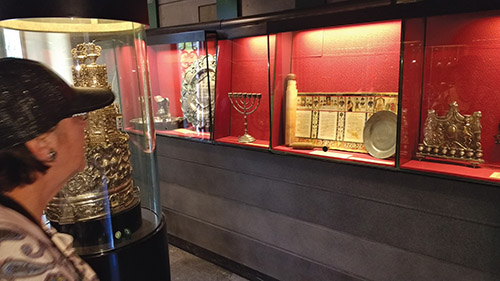





Venice has been on our “bucket list” since even before we realized we were entitled to one. Who would believe that a city can be constructed on canals and still remain above water! Currently Venice is slightly sinking but that does not prevent the construction of ultra-modern buildings alongside thousand-year-old constructions. One of the most breathtaking views we experienced in the City of Venice was atop a new and extravagant mall, featuring high-end stores, including some we had never heard of, situated within the confines of the constricted city. Venice hosts hundreds of thousands of tourists during the months of April through October who marvel at the modernity of the population as contrasted with the magnificently intricate facades of the centuries-old buildings. And imagine accompanying your children to school each morning on a water bus!
Now to Jewish Venice. We opted to stay at the Giardino del Melograni, the Jewish guest house within the New Ghetto. In retrospect, I was very pleased with our decision as I learned from the manager of the hotel that our stay helps defray the expenses of the Jewish community, now numbering 500, including the upkeep of the Jewish elementary school, Talmud Torah, kindergarten, old-age home and of course the five ancient synagogues. The profits also help host conferences and celebrations such as last March’s 500th-year anniversary of the ghetto. Giordana, one of the managers of the guest house, is a charming young Jewish Venetian educated in the Jewish kindergarten and Talmud Torah. Holding a degree in international science and diplomacy, she hopes to remain in Venice and make her future life in the city. She is happily ensconced at her job in the guest house as she meets interesting tourists from all over the world, Jewish and non-Jewish alike. She reported that in 2011 the guest house was expanded and refurbished and now hosts one full apartment and 20 rooms. The kosher breakfast offered with the stay features Chalav Yisroel products. Shabbat and chagim are strictly observed with accommodations for lights, candles and Shabbat-friendly keys. High season in the guest house is from September through October and then again from Carnival in February through the summer.
Adjacent to the guest house is Gimel Garden, a charming dairy restaurant overlooking the canal. As you traverse the ghetto, approximately the distance of Route 4 to the end of Votee Park, you pass three Jewish art galleries, two kosher groceries and bakeries, two Jewish gift shops and at the exit, the famously delicious fleishig Gam Gam restaurant, which is owned and operated by the Chabad community. Along the way, you can visit the Chabad information center and yeshiva as well as the J, the Jewish Community Center.
Located within the ghetto square is the historical Jewish Museum. Opened in 1953 in the Campo of the Ghetto Nuevo by the Jewish Community of Venice, the museum displays valuable vestments, sacred furnishings, historical ketubot and silver ritual ornaments dating from the seventh to the ninth centuries. The museum tour offers visits to three of the five extant Jewish synagogues including the Great German Schola, founded in 1528; the Schola Canton, founded in 1531; the Italian Schola, founded in 1575; the Levantine Schola, founded in 1541; and the Ponentine or Spanish Schola, founded in 1580. Currently the Levantine Synagogue is used in the winter months as it is heated and the Spanish synagogue is used in summer, as it is cool. Several Holocaust memorial panels adorn the walls of the ghetto, created by famous Venetian sculptor Arbit Blatas.
In my attempts to speak to the locals, I entered one of the two Judaica shops, called David’s Shop. A lovely store, it displays all types of Judaica made mainly with the famous Venetian Murano glass. According to owner Davide Curiel, the ritual Judaica pieces are created by his sister Doriana who can barely keep up with the demand, as they are the only Judaica craftsmen in the city. The Curiel family has owned this Judaica establishment for over 500 years, since their arrival in 1495. David has managed the shop for 33 years and sees his immediate as well as long-term future in the family business, through slow times as well as booming tourist seasons.
Chabad’s presence in the ghetto is manifest most charmingly through the young children, tzizit flying, racing and playing ball with the local Venetian children in the ghetto square. The Chabad Information Center provides information for tourists about Chabad establishments. The shul, housed in a separate building, provides davening three times daily as well as a beit midrash for study. The shul building also houses the yeshiva, which currently is home to seven young men from abroad who are studying for Smicha. The three local Chabad families reside within the ghetto walls or nearby. Their children study online with the children of many thousands of shluchim worldwide. After bar mitzvah, usually at age 15, the boys opt to study in Israel or Crown Heights. But when queried, home is the Venice ghetto.
As we walked the streets of the ghetto, over bridges and under low-lying overhangs, through narrow, winding streets, it was sobering to realize that 500 years ago our Italian brethren were forced to live within these confined quarters and were forbidden to leave between sunset and dawn. Today we come as free citizens of the world in an attempt to recreate our history and at the same time to show the world that “Am Yisroel Chai.”
By Pearl Markovitz










